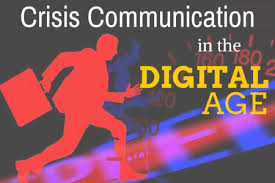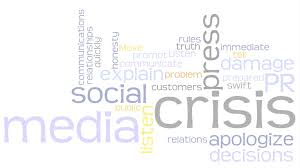With over 2 billion people using social media channels, its impact cannot be overstated. Facebook alone has 1.78 billion monthly users; nearly 400 million tweets are despatched from Twitter accounts everyday. Social media has undoubtedly redefined our communication landscape – it has changed the way information is transmitted and consumed.
This new-age phenomenon is a boon for companies and brands. Social media has enabled direct engagement and dialogue with consumers. It has offered unprecedented opportunity to build affinity and relationships.

What is worse, multiple channels with multiple users, means that organizations no longer have control over their messages – they get carried, amplified and often distorted, as news travels at lighting speed along consumer networks.
As such, social media has added significant complexity to crisis communication management. Be that as it may, communication managers cannot afford to ignore the powerful platform. Prudence lies in integrating social media into the overall crisis communication plan.
The fact is that whether organizations choose to participate or not, consumers will talk about them online, particularly when the news is bad. A more pragmatic approach is to be a part of the conversation, and stay in control of messaging and reputation.
Social media is a critical lever of crisis communication management in the digital age. The world’s online population, is more educated and more vocal than its offline counterpart. As such, it is highly likely that news of a corporate crisis will first break online.
Despite the potency of social media, only 30% of organizations around world have an effective crisis management plan, according to Burson Marstellar.
It goes without saying, that the time to start thinking about a crisis management planning is not during a crisis. Companies should invest in social media channels and nurture online customer relationships. The role of social media during a crisis, is to defend organizational reputation. Having already build online relationships, organizations should leverage these associations and draw upon goodwill during a crisis.

Many organizations, particularly those in the western world, are wary of ‘acknowledging’ the situation due to legal concerns. To be clear, acknowledgment does not mean accepting culpability, it simply means that the organization is acting responsibly and humanely.
To avoid any confusion, the crisis communication plan must outline roles and responsibilities. Key personnel such as organizational spokespeople, social media managers and customer service staff, should be appraised of the information they can legitimately share. They should be briefed on the organization’s communication strategy and messaging plan during a crisis. In particular, social media managers and customer service staff should be equipped with contact lists of spokespeople and ‘point persons’ to whom they can turn for specific information.
Additionally, it is important to train organizational spokespeople for crisis communication situations, so that they are not pressured into answering questions by persistent media reporters. Crisis communication training must pay particular heed to body language and tone of delivery, while addressing the media and the public at large.
Yet another best practise, is setting crisis thresholds for social media channels, outlining the volume and frequency of comments that warrant escalation. The guide post should be previous company and competitor trends. For example, less than 5 negative comments per day may be ‘business as usual’ and require no more than a compiled report for management review. On the other hand, an increased frequency of negativity, would warrant an alert to the Corporate Communication department.

If none exists, an employee social media policy should be drafted as part of the crisis communication planning initiative. These days, it is passe’ for organizations to restrict employee access to social media. Furnishing guidelines for employee online communication, is therefore, advisable. The policy should be reiterated during crisis situations, so that employees are clear on how to conduct themselves online.
Time is of the essence, once a crisis strikes. It is important to respond quickly. Organizations no longer have the luxury of issuing a press-release within 24 hours of a crisis. Social media has accelerated the speed and complexity of communication. If companies do not respond quickly, it is likely that multiple social media channels will carry and distort the message. The speed with which news travels on social media, has necessitated that organizations issue a preliminary statement within 1 hour of a crisis.
Prior to responding, is important to assess the situation and gauge the online sentiment about the organization. In fact, analyzing public opinion, good and bad, should be a regular part of online reputation management.
Monitoring conversations about the company, its competitors, and the industry, at critical outposts, is a good practise for all organizations to follow.
Social media managers should be tasked with monitoring online activities and escalation, as stipulated by crisis communication policy guidelines. Tools such as Hootsuite, Tweetreach, Tweetdeck, Google Alerts, Social Mention, Klout etc., enable seamless monitoring.
Conversations relating to the company, its brands, customers, competitors, the industry, CEO, senior management and organizational spokespeople, should be tracked.

That said, the importance of speed cannot be undermined. Within an hour of a crisis, a ‘first-response’ must be posted on social media channels. In keeping with crisis communication tenets, the message must acknowledge the crisis, express concern for those affected, commit to a full investigation and regular updates.
As important as messaging is, so too is the response medium. As a rule of thumb, the initial response should posted on the channel where the crisis first breaks, and thereafter, expanded to other communication channels. For example, if a crisis breaks on Twitter, it is appropriate to respond on that channel and carry the messages to other channels afterwards. All channels must be updated with pertinent information, and messaging must be integrated across platforms.

A critical part of crisis communication management is appraising key stakeholders. These include employees, customer service staff, PR agency, customers, business associates, investors etc. Stakeholders are vital brand ambassadors during a crisis, and should be briefed on the situation, including how the company is dealing with it.
The management team should reach out directly to employees, via email or face-to-face meetings, depending on the magnitude of the crisis. The social media policy should be reinforced and published (via email and employee intranet). Organizational spokespeople, social media managers, customer service staff, should be equipped with scripts and messages to respond to the situation. Personal letters to customers, associates and investors should be despatched, if the situation warrants.
Tone and tenor of communication are as important as content. Each social media channel has its own tone; the messages must be attuned to each individual channel.

Once the initial statement has been published, it may be necessary to issue a press-statement or hold a press briefing, depending on the situation. Once again, the message should acknowledge the situation, express concern for those affected, furnish verified facts and details, outline the actions taken by the organization, including immediate priorities and next steps, as well as contact persons for further information.
In keeping with crisis communication training, spokespeople should not to be dismissive or insensitive in their response to media questions. Tone of delivery and body language are of utmost importance.
Spokespeople should reinforce key messages, per the communication strategy. They should avoid speculating on why things went wrong, refrain from assigning blame, or discussing how things could have been done differently, or commenting on how the investigation will be conducted or what its outcome would be.

If the crisis impacts third-parties, it is necessary to coordinate with them before issuing press-releases. As a courtesy, all releases must be shared with the entities involved, so that the messaging is consistent and unified.
Social media channels must be actively monitored, so that organizational response is integrated and cohesive.
All ‘outbound’ communication including marketing, promotional material, ads, Facebook, Twitter, Instagram posts etc., must be reviewed for insensitive or inappropriate content. Automated messages are best aborted. It is better to manually review messages and access their appropriateness. Selling or promoting products or services during a crisis, should be curtailed – it would show the organization in a bad light and antagonize the public.
As the investigation progresses, updates must shared via traditional press-releases and social media posts. Key communication channels must be leveraged including:
Facebook:
Facebook is an important channel in communicating directly with the public. It is an integral lever during a crisis, because it allows for misinformation to be corrected in real-time. Facebook should be closely monitored and updated with relevant facts. Insensitive posts including promotional material, or exuberant images should be removed, so as to present a sober organizational face. Negative posts that go against company policy, may be hidden.
Website:
The company website is often the first place that customers, media and general public accesses for information during a crisis. Therefore, it must be updated with press-releases, management statements and other relevant information. As with Facebook, it is important to tone down or remove potentially offensive promotional material and insensitive images. A good crisis planning practise, is developing a sober version of the website for activation during emergency situations. While the branding is toned down, it is acceptable place links to the standard website, so that customers can access it if they wish.
CEO Blog:
If the organization publishes a CEO blog, it would be advisable to post a message or video addressing the crisis. Here again, tone and tenor are paramount. Authenticity cannot be compromised whatsoever. The CEO must portray a caring, responsible organization, committed to ‘doing the right thing’.
Twitter:
Twitter enables instant messaging and is effective in reaching a wider audience. Willingness to engage with a broader audience during a crisis, would bode well for organizational credibility. Given its 140 character limit, Twitter could used for brief updates, accompanied by links to the company website.
Instagram:
As with Facebook, photo-sharing sites such as Instagram, must be reviewed and insensitive photos removed.
YouTube:
If the company operates a YouTube channel, it would be appropriate to post a crisis related video message here. It is important to monitor YouTube and respond to comments, in keeping with crisis communication guidelines.
So too all online forums must be monitored. It is not advisable to post comments to these sites under a pseudonym – the consequences of being exposed are dire, to say the least. Posts should be under the company identity, and in keeping with the overall communication strategy. With that said, customers, brand ambassadors, and other influencers, may be encouraged to post on behalf of the organization.

Once the crisis is over, it is judicious to hold debriefing sessions, to evaluate the organizational response and refine the plan for the future.
Armed with a well-rehearsed plan, the organization will be ready to handle a crisis, no matter where or when it breaks – even if it is at 3 PM on a Sunday.
About the Author:

















